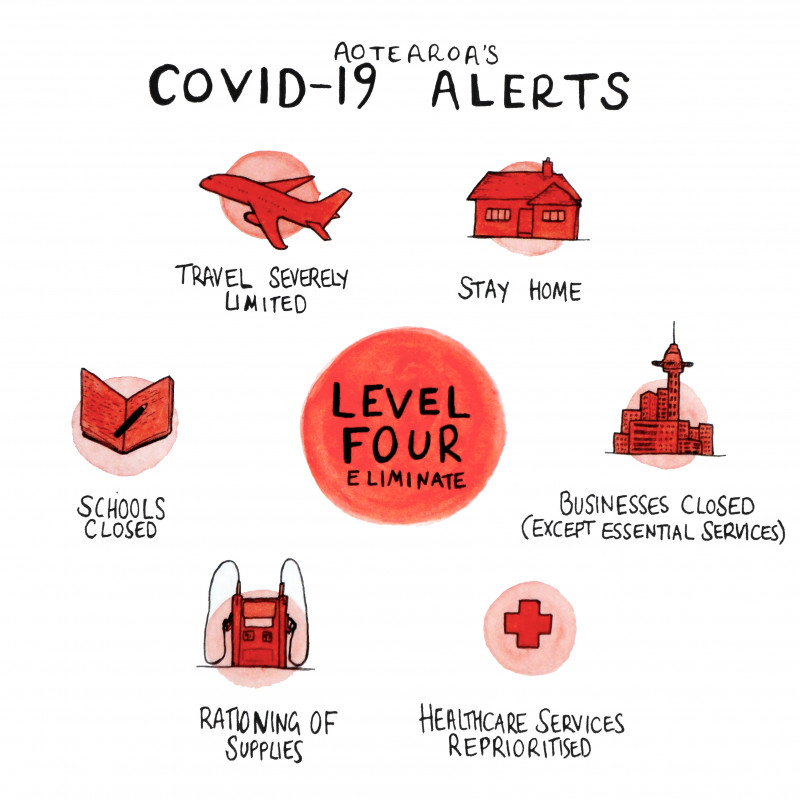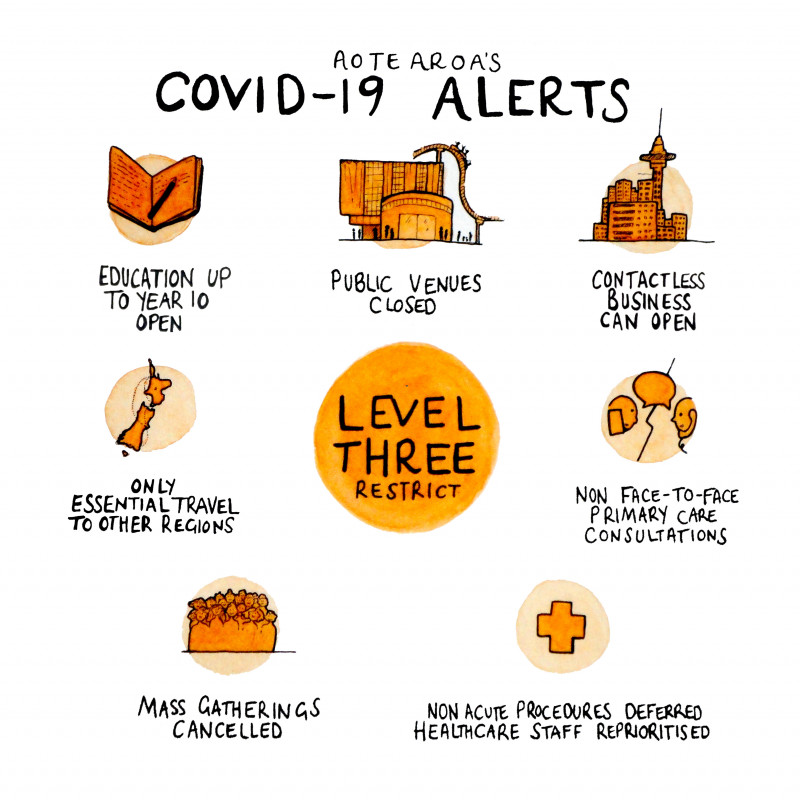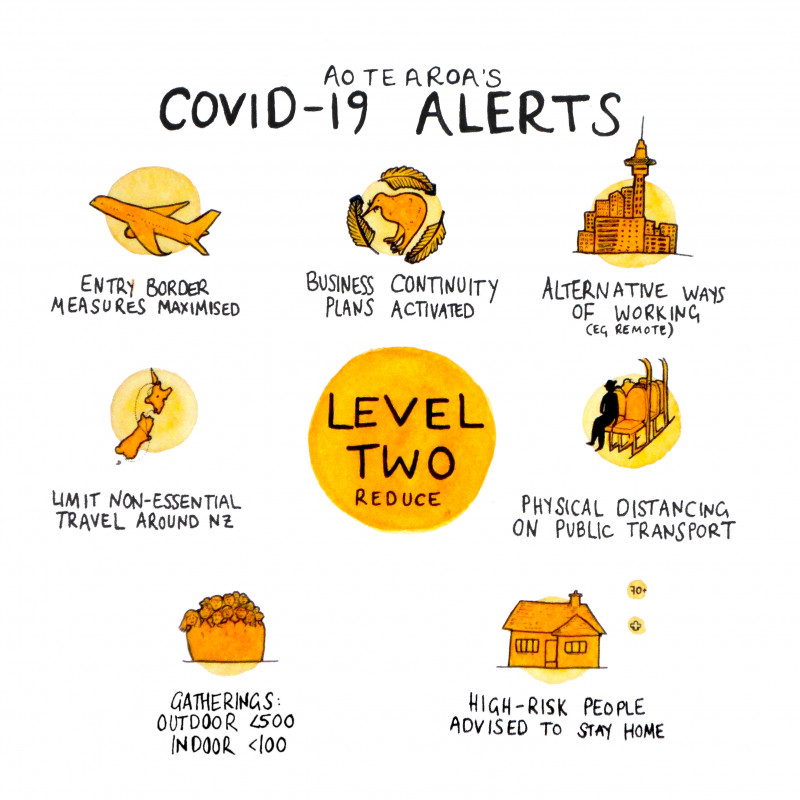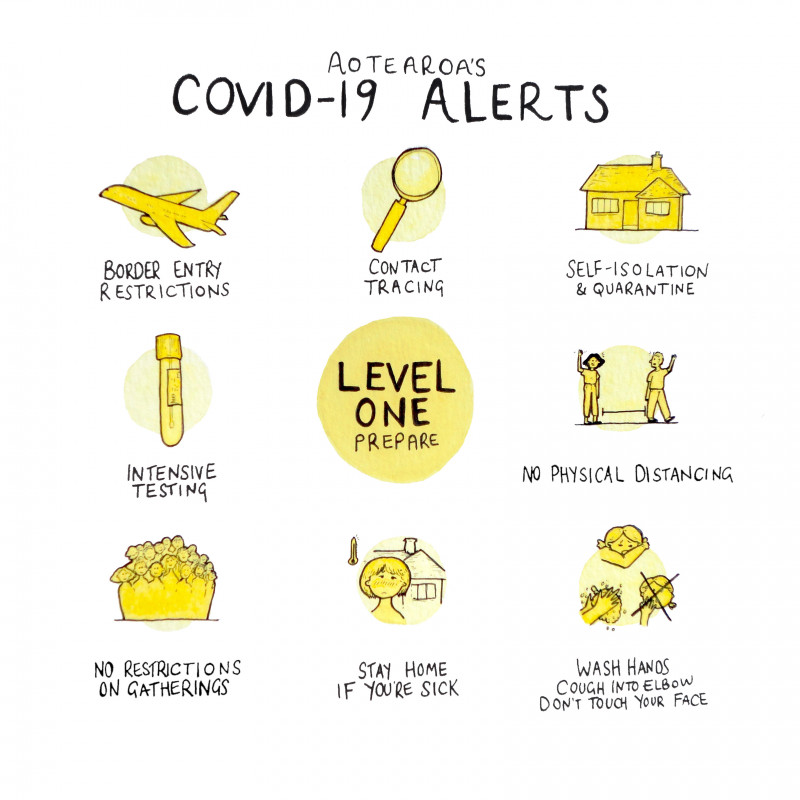By Anna Harcourt and Virginia Ngaio
New Zealand will move to alert level 3 at 11.59pm on Monday April 27. We’ve broken down what each alert level means, along with illustrations by Virginia Ngaio that show the range of possible measures at each level. We’ll keep updating this page as it becomes clear exactly what you can and can’t do at each level.
New Zealand’s Covid-19 alert levels are:
- Alert level 1: prepare
- Alert level 2: reduce
- Alert level 3: restrict
- Alert level 4: eliminate
Alert level 4: eliminate

Illustration: Virginia Ngaio @virginia.ngaio
After spending weeks at level 4, we’re all pretty familiar with what it means.
- No leaving the house except for essential services (supermarket or healthcare) or local walks.
- No seeing anyone outside your bubble.
- Education facilities closed.
- No travel, and certainly no takeaways.
- Total border closure.
- Physical distancing of 2 metres.
Alert level 3: restrict

Illustration: Virginia Ngaio @virginia.ngaio
Movement:
Stay at home, except for travel to:
- Local services and businesses
- Work or school
- Local recreation
- Moving house or a business
- Medical care
High-risk people (elderly and people with pre-existing medical conditions) should take additional precautions but can still work.
Physical distancing:
Keep 2 metres away from anyone outside your bubble, except for emergency and healthcare workers. In controlled environments like a workplace, keep 1 metre away.
Your bubble can be expanded slightly beyond your immediate household, for example if you have a caregiver, a partner caring for others, or a single person who wants the company of a sibling.
Business:
Businesses that can operate without any face-to-face contact with the public can open.
This means food delivery, drive-though, click-and-collect and online shopping can begin.
Public-facing bars, restaurants, cafes, malls and retail stores are not allowed to open.
Everyone who can work from home must do so. Industries that can’t work from home like forestry and construction or trades that go into other people’s homes like furniture removal, electricians or plumbers are allowed to open but must apply health and safety expectations like social distancing and good hygiene practices.
Education:
The Ministry of Education has clarified that preschools and schools will only be open for children who can't be cared for at home.
Previously it had been announced that preschools and schools up to Year 10 would be partially opened, with voluntary attendance.
"If there is a parent or caregiver available to look after children at home and school children have access to distance learning, children are encouraged to stay home," the Ministry's guidelines now say.
Children who do attend will be kept in their own school bubbles in small groups.
Tertiary education will all be online except things that must be done in person like lab work or trades training. Courses where close contact is unavoidable will remain online only.
Border:
Restrictions are in place. Mandatory quarantine or isolation for 14 days for people who have been overseas.
Health:
Primary healthcare services are open but use no-contact consultations where possible.
Recreation:
You can swim, surf or fish from the shore. But all recreation must be local and alone or in your bubble, and must be low-risk and non-motorised. Things like boating and jet skis are not allowed as they’re prone to accidents or breakdowns that lead you to have contact with others.
Transport:
You can use public transport for essential movement, but should avoid peak times, and not use it if you have symptoms of Covid-19, have tested positive or are awaiting a test result.
Travel to other regions is only allowed for:
- Essential workers
- To get to work or school in a neighbouring region
- Medical reasons, emergency services or court orders
- Moving home or a business
- New Zealanders who have been overseas to get to their home region, after 14 days mandatory quarantine
All other regional movement is not allowed.
Travel is also allowed for compassionate reasons but you must be given an official exemption.
No restrictions to domestic and international freight.
Gatherings and events (only funerals, tangihanga, weddings):
Weddings, funerals and tangihanga can go ahead but with no more than 10 people present, with no food or reception afterwards.
There must be a record of all attendees so contact tracing can be done if needed.
People must be able to stay 1 metre apart from each other. No one with Covid-19 symptoms is allowed to attend.
Public venues:
All public venues, like museums, food courts, gyms, pools, malls, farmers’ markets, playgrounds are closed.
Open spaces like parks are open but you need to keep 2 metres from those outside your bubble.
Alert level 2: reduce

Illustration: Virginia Ngaio @virginia.ngaio
Movement: Stay home where possible but there isn’t full restriction on movement. High-risk people (elderly and people with pre-existing medical conditions) should take additional precautions but can still work.
Physical distancing: Keep 1 metre away from anyone outside your bubble, especially on public transport.
Business: Open, but must operate safely with contact tracing systems and limits on numbers.
Workplaces should work from home where possible.
Education: Open from preschool through to tertiary. Distance learning is available for those who can’t attend (for example, if students are in self-isolation).
Any facility with contact with a confirmed or probable case must close for 72 hours, and potentially for a further 14 days.
Border: Restrictions are in place. Mandatory quarantine or isolation for 14 days for people who have been overseas.
Health: All health and disability care services fully open, but people must keep 1 metre apart. Remote consultations should be done where possible.
Recreation: Sport and recreation is allowed, including teams.
Transport: No restrictions on travel but people are advised to minimise non-essential travel.
You can use public transport except if you have symptoms of Covid-19, have tested positive or are awaiting a test result. No restrictions to domestic and international freight.
Gatherings and events (including funerals, tangihanga, weddings): Indoor gatherings have a limit of 100 people, outdoor gatherings have a limit of 500 people.
There must be a record of all attendees so contact tracing can be done if needed.
People must be able to stay 1 metre apart from each other. No one with Covid-19 symptoms is allowed to attend.
Public venues: Open but must comply with the limits on gatherings and events.
Alert level 1: prepare

Illustration: Virginia Ngaio @virginia.ngaio
Movement: No restrictions.
Physical distancing: Is not required.
Business: Open.
Education: Open from preschool through to tertiary. But any facility with contact with a confirmed or probable case must close for 72 hours, and potentially for a further 14 days.
Border: Restrictions are in place. Mandatory quarantine or isolation for 14 days for people who have been overseas.
Health: Stay home if you’re sick, and self-isolation if you have Covid-19 symptoms. All health and disability care services fully open.
Wash and dry your hands, cough into your elbow, don’t touch your face. Contact tracing for all probable and confirmed cases of Covid-19. Testing of all potential cases.
Recreation: Sport and recreation are allowed, including teams.
Transport: No restrictions on travel anywhere within New Zealand. You can use public transport freely, except if you have symptoms of Covid-19, have tested positive or are awaiting a test result. No restrictions to domestic and international freight.
Gatherings and public venues: No limits.